A Systematic Literature Review of Inclusive Climate Change Adaption
Abstract
1. Introduction
2. Materials and Methods
2.1. Data Selection
2.2. Data Collection and Analysis
3. Usage of Inclusiveness in Climate Change Adaptation
3.1. Growing Usage
3.2. Predominance of Practical Contexts
3.3. Predominance of Gender Issues
3.4. Predominance of Non-Annex 1 Countries
3.5. Inclusiveness at the Intersection of Development, Gender and Capacity in National Communications
4. Three Components of Inclusive Climate Change Adaptation
4.1. Inclusion in Who or What Adapts
4.2. Motivating Inclusive Processes
4.3. Anticipated Outcomes of Inclusive CCA
5. Implications for National Climate Change Adaptation Policy
6. Conclusions
Author Contributions
Funding
Acknowledgments
Conflicts of Interest
References
- IPCC. Climate Change 2014: Impacts, Adaptation and Vulnerability, Working Group II Contribution to the IPCC Fifth Assessment Report; Cambridge University Press: Cambridge, UK, 2014. [Google Scholar] [CrossRef]
- Dalby, S.; O’Lear, S. Towards ecological geopolitics. In Reframing Climate Change: Constructing Ecological Geopolitics; Dalby, S., O’Lear, S., Eds.; Routledge: London, UK; New York, NY, USA, 2016; pp. 203–216. [Google Scholar]
- Lynch, P.; Duke, S. Climate Change. In Environmental Politics: Scale and Power; O’Lear, S., Ed.; Routledge: London, UK; New York, NY, USA, 2010; pp. 27–54. [Google Scholar] [CrossRef]
- Pelling, M. Adaptation to Climate Change: From Resilience to Transformation; Routledge: London, UK; New York, NY, USA, 2011. [Google Scholar]
- Farber, D.A.; Posner, B.E.A.; Weisbach, D. Climate justice: Climate change, resource conflicts, and social justice. In Reframing Climate Change. Constructing Ecological Geopolitics; O’Lear, S., Dalby, S., Eds.; Routledge: London, UK; New York, NY, USA, 2016; pp. 67–82. [Google Scholar]
- Few, R.; Brown, K.; Tompkins, E.L. Public participation and climate change adaptation: Avoiding the illusion of inclusion. Clim. Policy 2007, 7, 46–59. [Google Scholar] [CrossRef]
- UNFCCC. Report of the Ad Hoc Working Group on the Durban Platform for Enhanced Action-Synthesis report on the aggregate effect of the intended nationally determined contributions. In Proceedings of the Conference of the Parties Twenty-First Session Paris, Paris, France, 30 November–11 December 2015; Available online: https://unfccc.int/resource/docs/2015/cop21/eng/07.pdf (accessed on 2 July 2020).
- IPCC. Global Warming of 1.5 °C. An IPCC Special Report on the Impacts of Global Warming of 1.5 °C Above Pre-Industrial Levels and Related Global Greenhouse Gas Emission Pathways, in the Context of Strengthening the Global Response to the Threat of Climate Change, Sustainable Development, and Efforts to Eradicate Poverty; Masson-Delmotte, V., Zhai, P., Pörtner, H.-O., Roberts, D., Skea, J., Shukla, P.R., Pirani, A., Moufouma-Okia, W., Péan, C., Pidcock, R., et al., Eds.; 2018; Available online: https://www.ipcc.ch/sr15/ (accessed on 20 July 2020).
- UNFCCC. UN Climate Change Annual Report 2017. 2018. Available online: https://unfccc.int/resource/annualreport/ (accessed on 20 July 2020).
- Government of Canada. Working Group on Adaptation and Climate Resilience. 2016. Available online: http://www.climatechange.gc.ca/Content/6/4/7/64778DD5-E2D9-4930-BE59-D6DB7DB5CBC0/WG_Report_ACR_e_v5.pdf (accessed on 20 July 2020).
- Southern Voices on Adaptation. Joint Principles for Adaptation. 2015. Available online: http://southernvoices.net/images/Joint_Principles_for_Adaptation_version_3.pdf (accessed on 20 July 2020).
- The United Kingdom Climate Impacts Program (UKCIP). Objective Setting for Climate Change. 2005. Available online: http://www.ukcip.org.uk/publications/ (accessed on 20 July 2020).
- Patnaik, H.A. Gender and participation in community-based adaptation: Evidence from the decentralized climate funds project in Senegal. World Dev. 2021, 142, 105448. [Google Scholar] [CrossRef]
- Bloomfield, D.; Collins, K.; Fry, C.; Munton, R. Deliberation and inclusion: Vehicles for increasing trust in UK public governance? Environ. Plan. C Gov. Policy 2001, 19, 501–513. [Google Scholar] [CrossRef]
- Mittag, J. Perspectives on civic engagement in national strategies to combat climate change. Democratization 2012, 19, 994–1013. [Google Scholar] [CrossRef]
- Reed, M.G. Stakeholder Participation for Environmental Management: A Literature Review. Biol. Conserv. 2008, 141, 2417–2431. [Google Scholar] [CrossRef]
- Ayers, J. Resolving the Adaptation Paradox: Exploring the Potential for Deliberative Adaptation Policymaking in Bangladesh. Glob. Environ. Politics 2011, 11, 62–88. [Google Scholar] [CrossRef]
- Nightingale, A.; Rankin, K. Politics of Social Marginalization and Inclusion: The Challenges of Adaptation to Climate Change. In Inclusive Urbanization: Rethinking Policy, Practice and Research in the Age of Climate Change; Shrestha, K., Ojha, H., McManus, P., Rubbo, A., Dhote, K., Eds.; Routledge: New York, NY, USA; London, UK, 2014; pp. 53–64. [Google Scholar]
- Buechler, S. Gendered vulnerabilities and grassroots adaptation initiatives in home gardens and small orchards in Northwest Mexico. AMBIO 2016, 45, 322–334. [Google Scholar] [CrossRef]
- Singh, C. Is participatory watershed development building local adaptive capacity? Findings from a case study in Rajasthan. India Environ. Dev. 2018, 25, 43–58. [Google Scholar] [CrossRef]
- Wilk, J.; Jonsson, A.C.; Rydhagen, B.; Callejo, I.; Cerruto, N. Assessing vulnerability in Cochabamba, Bolivia and Kota, India: How do stakeholder processes affect suggested climate adaptation interventions? Int. J. Urban. Sustain. Dev. 2018, 10, 32–48. [Google Scholar] [CrossRef]
- Sen, A. Social Exclusion: Concept, Application, and Scrutiny. Manila, Philippines: Asian Development Bank (ADB). 2000. Available online: http://hdl.handle.net/11540/2339 (accessed on 20 July 2020).
- The United Nations Department of Economic and Social Affairs (UNDESA). 2009. Final Report of the Expert Group Meeting on Creating an Inclusive Society: Practical Strategies to Promote Social Integration. Available online: http://www.un.org/esa/socdev/egms/docs/2008/Paris-report.pdf (accessed on 20 July 2020).
- Mello, L.; Dutz, M.A. (Eds.) Promoting Inclusive Growth: Challenges and Policies; OECD Publishing: Paris, France, 2012. [Google Scholar] [CrossRef]
- OECD. Policy Shaping and Policy Making: The Governance of Inclusive Growth; OECD Publishing: Paris, France, 2015. [Google Scholar]
- Gilman, H.R. More Inclusive Governance in the Digital Age (Data- Smart City Solutions). 2015. Available online: https://datasmart.ash.harvard.edu/assets/content/InclusiveGovernanceinthe (accessed on 2 July 2020).
- Ison, R.L.; Wallis, P.J. Mechanisms for Inclusive Governance. In Freshwater Governance for the 21st Century; Karar, E., Ed.; Springer: Cham, Switzerland, 2017; pp. 159–185. [Google Scholar] [CrossRef]
- Cruz, C.; Cadornigara, S.F.; Satterthwaite, D. Tools for Inclusive Cities: The Roles of Community-Based Engagement and Monitoring in Reducing Poverty (IIED Working Paper No. 10708). 2014. Available online: http://pubs.iied.org/pdfs/10708IIED (accessed on 2 July 2020).
- Florian, S.; Michael, L. Inclusive Cities. Asian Development Bank-Urban. Development Series. 2011. Available online: https://www.adb.org/sites/default/files/publication/29053/inclusive-cities.pdf (accessed on 2 July 2020).
- Shrestha, K.; Ojha, H.; McManus, P. Inclusive Urbanization: Rethinking Policy, Practice and Research in the Age of Climate Change; Routledge: New York, NY, USA; London, UK, 2015. [Google Scholar]
- World Bank. World Bank Inclusive Cities Approach Paper. Report No: AUS8539. 2015. Available online: http://documents.worldbank.org/curated/en/402451468169453117/pdf/AUS8539-REVISED-WP-P148654-PUBLIC-Box393236B-Inclusive-Cities-Approach-Paper-w-Annexes-final.pdf (accessed on 20 July 2020).
- Agola, N.; Hunter, A. Inclusive Innovation for Sustainable Development: Theory and Practice; Palgrave Macmillan: London, UK; Hunter: West Palm Beach, FL, USA, 2016. [Google Scholar]
- Government of Canada. Canada-A Nation of Innovators. 2016. Available online: https://www.ic.gc.ca/eic/site/062.nsf/vwapj/InnovationNation_Report-EN.pdf/$file/InnovationNation_Report-EN.pdf (accessed on 20 July 2020).
- Schillo, R.S.; Robinson, R.M.; Sainte-Marie, B. Inclusive Innovation in Developed Countries: The Who, What, Why, and How. Technol. Innov. Manag. Rev. 2017, 7, 34–46. Available online: https://timreview.ca/sites/default/files/article_PDF/SchilloRobinson_TIMReview_July2017.pdf (accessed on 20 July 2020). [CrossRef]
- Tompkins, E.; Adger, W.N.; Brown, K. Institutional networks for inclusive coastal management in Trinidad and Tobago. Environ. Plan. A 2002, 34, 1095–1111. [Google Scholar] [CrossRef]
- Archer, D.; Almansi, F.; DiGregorio, M.; Roberts, D.; Sharma, D.; Syam, D. Moving towards inclusive urban adaptation: Approaches to integrating community-based adaptation to climate change at city and national scale. Clim. Dev. 2014, 6, 345–356. [Google Scholar] [CrossRef]
- Chu, E.; Anguelovski, I.; Carmin, J. Inclusive approaches to urban climate adaptation planning and implementation in the Global South. Clim. Policy 2016, 16, 372–392. [Google Scholar] [CrossRef]
- Berrang-Ford, L.; Pearce, T.; Ford, J.D. Systematic review approaches for global environmental change research. Reg. Environ. Chang. 2015, 15, 755–769. [Google Scholar] [CrossRef]
- Berrang-Ford, L.; Ford, J.D.; Patterson, J. Are we adapting to climate change? Glob. Environ. Chang. 2011, 21, 25–33. [Google Scholar] [CrossRef]
- Biesbroek, G.R.; Termeer, C.; Klostermann, J.E.M.; Kabat, P. Analytical lenses on barriers in the governance of climate change adaptation. Mitig. Adapt. Strateg. Glob. Chang. 2015, 19, 1011–1032. [Google Scholar] [CrossRef]
- Ford, J.D.; Pearce, T. What we know, do not know, and need to know about climate change vulnerability in the western Canadian Arctic: A systematic literature review. Environ. Res. Lett 2010, 5, 014008. [Google Scholar] [CrossRef]
- Lesnikowski, A.C.; Ford, J.D.; Berrang-Ford, L.; Paterson, J.A.; Barrera, M.; Heymann, S.J. Adapting to health impacts of climate change: A study of UNFCCC Annex I parties. Environ. Res. Lett. 2011, 6, 044009. [Google Scholar] [CrossRef]
- Jafry, T.; Mikulewicz, M.; Helwig, K. (Eds.) Routledge Handbook of Climate Justice; Routledge: London, UK, 2018. [Google Scholar] [CrossRef]
- Hughes, S. Justice in urban climate change adaptation: Criteria and application to Delhi. Ecol. Soc. 2013, 18, 48. [Google Scholar] [CrossRef]
- Bulkeley, H.; Gareth, A.; Edwards, S.; Fuller, S. Contesting climate justice in the city: Examining politics and practice in urban climate change experiments. Glob. Environ. Chang. 2014, 25, 31–40. [Google Scholar] [CrossRef]
- Figueiredo, P.; Perkins, P.E. Women and water management in times of climate change: Participatory and inclusive processes. J. Clean. Prod. 2013, 60, 188–194. [Google Scholar] [CrossRef]
- Jafry, T. Making the case for gender sensitive climate policy–lessons from South Asia/IGP. Int. J. Clim. Chang. Strateg. Manag. 2016, 8, 559–577. [Google Scholar] [CrossRef]
- Nurhidayah, L.; McIlgorm, A. Coastal adaptation laws and the social justice of policies to address sea level rise: An Indonesian insight. Ocean Coast. Manag. 2019, 171, 11–18. [Google Scholar] [CrossRef]
- Ingle, H.I.; Mikulewicz, M. Mental health and climate change: Tackling invisible injustice. Lancet Planet Health 2020, 4, e128–e130. [Google Scholar] [CrossRef]
- Forsyth, T. Climate justice is not just ice. Geoforum 2014, 54, 230–232. [Google Scholar] [CrossRef]
- Schlosberg, D. Theorizing environmental justice: The expanding sphere of a discourse. Environ. Politics 2013, 22, 37–55. [Google Scholar] [CrossRef]
- Tschakert, P.; Schlosberg, D.; Celermajer, D.; Rickards, L.; Winter, C.; Thaler, M.; Stewart-Harawira, M.; Verlie, B. Multispecies justice: Climate-just futures with, for and beyond humans. WIREs Clim. Chang. 2021, 12, e699. [Google Scholar] [CrossRef]
- Cooper, H.; Hedge, L.V. (Eds.) The Handbook of Research Synthesis; Russell Sage Foundation: New York, NY, USA, 1994. [Google Scholar]
- Gough, D.; Thomas, J.; Oliver, S. Clarifying differences between review designs and methods. Syst. Rev. 2012, 1, 28–37. [Google Scholar] [CrossRef]
- Lorenz, S.; Berman, R.; Dixon, J.; Lebel, S. Time for a systematic review: A response to Bassett and Fogelman’s “Deja vu or something new? The adaptation concept in the climate change literature”. Geoforum 2014, 51, 252–255. [Google Scholar] [CrossRef]
- McLeman, R.A. Settlement abandonment in the context of global environmental change. Glob. Environ. Chang. Hum. Policy Dimens 2011, 21, S108–S120. [Google Scholar] [CrossRef]
- Gill, G. The Nature and Development of the Modern State; Palgrave: London, UK, 2003. [Google Scholar]
- Meadowcroft, J. Climate Change Governance; Policy Research Working Paper No. WPS 4941; World Bank Group: Washington, DC, USA, 2009; Available online: http://documents.worldbank.org/curated/en/210731468332049368/Climate-change-governance (accessed on 20 July 2020).
- Oulu, M. Climate Change Governance: Emerging Legal and Institutional Frameworks for Developing Countries. In Handbook of Climate Change Adaptation; Leal Filho, W., Ed.; Springer: Berlin/Heidelberg, Germany, 2015. [Google Scholar] [CrossRef]
- Pierre, J.; Peters, G. Governance, Politics and the State; Macmillan Press: London, UK, 2000. [Google Scholar]
- Smit, B.; Burton, I.; Klein, R. The Science of Adaptation: A Framework for Assessment. Mitig. Adapt. Strateg. Glob. Chang. 1999, 4, 199–213. [Google Scholar] [CrossRef]
- Smit, B.; Burton, I.; Klein, R.; Wandel, J. An anatomy of adaptation to climate change and variability. Clim. Chang. 2000, 45, 223–251. [Google Scholar] [CrossRef]
- Agrawal, A. The Role of Local Institutions in Adaptation to Climate Change. 2008. Available online: http://www.icarus.info/wp-content/uploads/2009/11/agrawal-adaptation-institutions-livelihoods.pdf (accessed on 20 July 2020).
- Butcher-Gollach, C. Planning, the urban poor and climate change in Small Island Developing States (SIDS): Unmitigated disaster or inclusive adaptation? Int. Dev. Plan. Rev. 2015, 37, 225–248. [Google Scholar] [CrossRef]
- Aoyagi, M.; Suda, E.; Shinada, T. Gender Inclusion in Climate Change Adaptation; ADBI Working Paper, No. 309; Asian Development Bank Institute (ADBI): Tokyo, Japan, 2011. [Google Scholar]
- Habtezion, S. Gender and Climate Change Asia and the Pacific. United Nations Development Programme. 2013. Available online: http://www.undp.org/content/dam/undp/library/gender/GenderandEnvironment/PB1-AP-Overview-Gender-and-climate-change.pdf (accessed on 20 July 2020).
- Habtezion, S. Gender, Climate Change Adaptation and Disaster Risk Reduction. 2016. Available online: http://www.undp.org/content/dam/undp/library/gender/GenderandEnvironment/TrainingModules/Gender_Climate_Change_TrainingModule2AdaptationDRR.pdf (accessed on 20 July 2020).
- Schalatek, L.; Nakhooda, S. Gender and Climate Finance. 2013. Available online: https://www.odi.org/sites/odi.org.uk/files/resource-documents/11046.pdf (accessed on 2 July 2020).
- United Nations Development Program (UNDP). Resource Guide on Gender and Climate Change. 2009. Available online: https://www.undp.org/content/undp/en/home/librarypage/womens-empowerment/resource-guide-on-gender-and-climate-change.html (accessed on 2 July 2020).
- UNDP. Gender and Adaptation: Africa. 2012. Available online: https://www.undp.org/content/undp/en/home/librarypage/womens-empowerment/gender_and_environmentenergy/gender_and_climatechange-africa.html (accessed on 20 July 2020).
- Green Climate Fund. GCF Gender Equality and Social Inclusion Policy and Action Plan. 2018–2020. In Proceedings of the Meeting of the Board, Songdo, Incheon, Korea, 27 February–1 March 2018; Songdo Provisional agenda item 16 GCF/B.19/25. Available online: https://www.greenclimate.fund/sites/default/files/document/gcf-b19-25.pdf (accessed on 20 July 2020).
- NDF & Asian Development Bank. Training Manual to Support Country-Driven Gender and Climate Change. 2015. Available online: https://pub.iges.or.jp/pub/training-manual-support-country-driven-gender (accessed on 20 July 2020).
- UNDP. Gender Responsive National Communications National Communication. 2015. Available online: https://www.undp.org/content/undp/en/home/librarypage/womens-empowerment/gender-responsive-national-communications.html (accessed on 20 July 2020).
- UNFCCC. Strengthening Gender Considerations in Adaptation Planning and Implementation in the Least Developed Countries. 2015. Available online: https://www4.unfccc.int/sites/NAPC/Documents%20NAP/UNFCCC_gender_in_NAPs.pdf (accessed on 20 July 2020).
- Dulal, H.B.; Shah, K.U.; Ahmad, N. Social equity considerations in the implementation of Caribbean climate change adaptation policies. Sustainability 2009, 1, 363–383. [Google Scholar] [CrossRef]
- Resurrección, B.P.; Bee, B.A.; Dankelman, I.; Park, C.M.Y.; Halder, M.; McMullen, C.P. Gender-Transformative Climate Change Adaptation: Advancing Social Equity; Background Paper to the 2019 Report of the Global Commission on Adaptation: Rotterdam, The Netherlands; Washington, DC, USA, 2019; Available online: https://www.sei.org/publications/gender-transformative-climate-change-adaptation-advancing-social-equity/#:~:text=Power%20and%20gender%20inequalities%20can%20constrain%20and%20undermine%20climate%20change%20adaptation.&text=Unfettering%20the%20agency%20of%20individuals,can%20help%20achieve%20this%20change (accessed on 20 July 2020).
- United Nations Framework of Climate Change Convention (UNFCCC). United Nation Framework of Climate Change Convention. 1994. Available online: https://unfccc.int/resource/docs/convkp/conveng.pdf (accessed on 20 July 2020).
- Adger, N.; Paavola, J.; Huq, S.; Mace, M.J. (Eds.) Fairness in Adaptation to Climate Change; MIT Press: Cambridge, MA, USA, 2006. [Google Scholar]
- Yoseph-Paulus, R.; Hindmarsh, R. Addressing inadequacies of sectoral coordination and local capacity building in Indonesia for effective climate change adaptation. Clim. Dev. 2018, 10, 35–48. [Google Scholar] [CrossRef]
- Köpsel, V.; Walsh, C. Coastal landscapes for whom? Adaptation challenges and landscape management in Cornwall. Mar. Policy 2018, 97, 278–286. [Google Scholar] [CrossRef]
- Ayers, J. Understanding the Adaptation Paradox: Can. Global Climate Change Adaptation Policy Be Locally Inclusive? Ph.D. Thesis, London School of Economics, London, UK, 2010. Available online: http://etheses.lse.ac.uk/393/1/Ayers (accessed on 20 July 2020).
- Fazey, I.; Kesby, M.; Evely, A.; Latham, I.; Wagatora, D.; Hagasua, J.E.; Reed, M.S.; Christie, M. A three-tiered approach to participatory vulnerability assessment in the Solomon Islands. Glob. Environ. Chang. 2010, 20, 713–728. [Google Scholar] [CrossRef]
- Dowsley, M. Community clusters in wildlife and environmental management: Using TEK and community involvement to improve co-management in an era of rapid environmental change. Polar Res. 2009, 28, 43–59. [Google Scholar] [CrossRef]
- Makina, A.; Moyo, T. Mind the gap: Institutional considerations for gender-inclusive climate change policy in Sub-Saharan Africa. Local Environ. 2016, 21, 1185–1197. [Google Scholar] [CrossRef]
- Nagy, G.J.; Seijo, L.; Verocai, J.E.; Bidegain, M. Stakeholders’ climate perception and adaptation in coastal Uruguay. Int. J. Clim. Chang. Strateg. Manag. 2014, 6, 63–84. [Google Scholar] [CrossRef]
- Hill, M.; Wallner, A.; Furtado, J. Reducing vulnerability to climate change in the Swiss Alps: A study of adaptive planning. Clim. Policy 2010, 10, 70–86. [Google Scholar] [CrossRef]
- Vij, S.; Biesbroek, R.; Groot, A.; Termeer, K.; Parajuli, B.P. Power interplay between actors: Using material and ideational resources to shape local adaptation plans of action (LAPAs) in Nepal. Clim. Policy 2018, 19, 1–14. [Google Scholar] [CrossRef]
- Fenton, A.; Gallagher, D.; Wright, H.; Huq, S.; Nyandiga, C. Up-scaling finance for community-based adaptation. Clim. Dev. 2014, 6, 388–397. [Google Scholar] [CrossRef]
- Ramirez-Villegas, J.; Khoury, C.K. Reconciling approaches to climate change adaptation for Colombian agriculture. Clim. Chang. 2013, 119, 575–583. [Google Scholar] [CrossRef][Green Version]
- McNamara, K.E.; Des Combes, H.J. Planning for Community Relocations Due to Climate Change in Fiji. Int. J. Disaster Risk Sci. 2015, 6, 315–319. [Google Scholar] [CrossRef]
- Neuburger, M. Global discourses and the local impacts in Amazonia. Inclusion and exclusion processes in the Rio Negro region. Erdkunde 2008, 62, 339–356. [Google Scholar] [CrossRef]
- Arriagada, R.A.; Aldunce, P.; Blanco, G.; Ibarra, C.; Moraga, P.; Nahuelhual, L.; O’Ryan, R.; Urquiza, A.; Gallardo, L. Climate change governance in the Anthropocene: Emergence of Polycentrism in Chile. Elem. Sci. Anth. 2018, 6, 1–13. [Google Scholar] [CrossRef]
- Schmid, J.C.; Knierim, A.; Knuth, U. Policy-induced innovations networks on climate change adaptation-An ex-post analysis of collaboration success and its influencing factors. Environ. Sci. Policy 2016, 56, 67–79. [Google Scholar] [CrossRef]
- Sprain, L. Paradoxes of Public Participation in Climate Change Governance. Good Soc. 2016, 25, 62–80. [Google Scholar] [CrossRef]
- Ernst, K.M.; van Riemsdijk, M. Climate change scenario planning in Alaska’s National Parks: Stakeholder involvement in the decision-making process. Appl. Geogr. 2013, 45, 22–28. [Google Scholar] [CrossRef]
- Wani, K.A.; Ariana, L. Impact of climate change on indigenous people and adaptive capacity of bajo tribe, Indonesia. Environ. Claims J. 2018, 30, 302–313. [Google Scholar] [CrossRef]
- Lee, J. Farmer participation in a climate-smart future: Evidence from the Kenya agricultural carbon market project. Land Use Policy 2017, 68, 72–79. [Google Scholar] [CrossRef]
- Bhatasara S Rethinking climate change research in Zimbabwe. J. Environ. Stud. Sci. 2017, 7, 39–52. [CrossRef]
- Abrha, M.G.; Simhadri, S. Local Climate Trends and Farmers’ Perceptions in Southern Tigray, Northern Ethiopia. Am. J. Environ. Sci. 2015, 11, 262–277. [Google Scholar] [CrossRef]
- Regmi, B.R.; Star, C. Identifying operational mechanisms for mainstreaming community-based adaptation in Nepal. Clim. Dev. 2014, 6, 306–317. [Google Scholar] [CrossRef][Green Version]
- Regmi, B.R.; Star, C.; Leal Filho, W. An overview of the opportunities and challenges of promoting climate change adaptation at the local level: A case study from a community adaptation planning in Nepal. Clim. Chang. 2016, 138, 537–550. [Google Scholar] [CrossRef]
- Luo, X.; Muleta, D.; Hu, Z.; Tang, H.; Zhao, Z. Inclusive development and agricultural adaptation to climate change. Curr. Opin. Environ. Sustain. 2017, 24, 78–83. [Google Scholar] [CrossRef]
- Polsky, C.; Neff, R.; Yarnal, B. Establishing vulnerability observatory networks to coordinate the collection and analysis of comparable data. In Sustainable Communities on a Sustainable Planet: The Human-Environment Regional Observatory Project; Yarnal, B., Polsky, C., O’Brien, J., Eds.; Cambridge University Press: Cambridge, UK, 2009; pp. 83–106. [Google Scholar]
- Gupta, J.; Bavinck, M. Reprint of Inclusive development and coastal adaptiveness. Ocean. Coast. Manag. 2017, 150, 73–81. [Google Scholar] [CrossRef]
- Robin, L. Environmental humanities and climate change: Understanding humans geologically and other life forms ethically. Wiley Interdiscip. Rev. Clim. Chang. 2018, 9, 7–9. [Google Scholar] [CrossRef]
- Ford, J.D.; Cameron, L.; Rubis, J.; Maillet, M.; Nakashima, D. Including indigenous knowledge and experience in IPCC assessment reports. Nat. Clim. Chang. 2016, 6, 349–353. [Google Scholar] [CrossRef]
- Hardy, R.D.; Milligan, R.A.; Heynen, N. Racial coastal formation: The environmental injustice of colorblind adaptation planning for sea-level rise. Geoforum 2017, 87, 62–72. [Google Scholar] [CrossRef]
- Jonsson, A.C.; Rydhagen, B.; Wilk, J.; Feroz, A.; Rani, R. Climate change adaptation in urban india: The inclusive formulation of local adaptation strategies. Global NEST. Int. J. 2015, 17, 61–71. [Google Scholar]
- Plante, S.; Vasseur, L.; Da Cunha, C. Engaging Local Communities for Climate Change Adaptation. In Coastal Zones: Solutions for the 21st Century; Baztan, J., Chouinard, O., Jorgensen, B., Tett, P., Vanderlinden, J., Vasseur, L., Eds.; Elsevier: Amsterdam, The Netherlands, 2015. [Google Scholar] [CrossRef]
- Wesche, S.D.; Armitage, D.R. Using qualitative scenarios to understand regional environmental change in the Canadian North. Reg. Environ. Chang. 2014, 14, 1095–1108. [Google Scholar] [CrossRef]
- Rodríguez-Romero, A.; Viguri, J.R.; Calosi, P. Acquiring an evolutionary perspective in marine ecotoxicology to tackle emerging concerns in a rapidly changing ocean. Sci. Total Environ. 2021, 764, 142816. [Google Scholar] [CrossRef]
- Pielke, R.A.; Wilby, R.; Niyogi, D.; Hossain, F.; Dairuku, K. Dealing with Complexity and Extreme Events Using a Bottom-Up, Resource-Based Vulnerability Perspective. Extrem. Events Nat. Hazards Complex. Perspect. 2013, 196, 345–359. [Google Scholar] [CrossRef]
- Reed, M.G.; Scott, A.; Natcher, D.; Johnston, M. Linking gender, climate change, adaptive capacity, and forest-based communities in Canada. Can. J. For. Res. 2014, 44, 995–1004. [Google Scholar] [CrossRef]
- Fischer, H. Decentralization and the governance of climate adaptation: Situating community-based planning within broader trajectories of political transformation. World Dev. Vol. 2021, 140, 105335. [Google Scholar] [CrossRef]
- Huntjens, P.; Zhang, T.; Nachbar, K. Climate Change and Implications for Security and Justice: The Need for Equitable, Inclusive, and Adaptive Governance of Climate Action. In Just Security in an Undergoverned World; Durch, W., Larik, J., Ponzio, R., Eds.; Oxford University Press: Oxford, UK, 2018. [Google Scholar] [CrossRef]
- Chu, E.; Anguelovski, I.; Roberts, D. Climate adaptation as strategic urbanism: Assessing opportunities and uncertainties for equity and inclusive development in cities. Cities 2017, 60, 378–387. [Google Scholar] [CrossRef]
- Bäckstrand, K. Accountability of Networked Climate Governance: The Rise of Transnational Climate Partnerships. Glob. Environ. Politics 2008, 8, 74–102. [Google Scholar] [CrossRef]
- Hölscher, K.; Frantzeskaki, N.; McPhearson, T.; Loorbach, D. Tales of transforming cities: Transformative climate governance capacities in New York City, U.S. and Rotterdam, Netherlands. J. Environ. Manag. 2019, 231, 843–857. [Google Scholar] [CrossRef] [PubMed]
- Pattberg, P. Public-private partnerships in global climate governance. Wiley Interdiscip. Rev. Clim. Chang. 2010, 1, 279–287. [Google Scholar] [CrossRef]
- Ayers, J.; Huq, S. Adaptation, development and the community. In Climate Adaptation Futures; Palutikof, J., Boulter, S., Ash, A., Smith, M.S., Parry, M., Waschka, M., Guitart, D., Eds.; John Wiley & Sons, Ltd.: Hoboken, NJ, USA, 2013; pp. 203–214. [Google Scholar]
- Glavovic, B.C. Adapting to climate change: Lessons from natural hazards planning. Waves of Adversity, Layers of Resilience: Floods, Hurricanes, Oil Spills and Climate Change in the Mississippi Delta. In Adapting to Climate Change: Lessons from Natural Hazards Planning; Glavovic, B.C., Smith, G.P., Eds.; Springer: Dordrecht, The Netherlands; Heidelberg, Germany; New York, NY, USA; London, UK, 2014; pp. 369–404. [Google Scholar] [CrossRef]
- Ostrom, E.; Ahn, T.K. Foundations of Social Capital; Edward Elgar Pub.: Northampton, MA, USA, 2003. [Google Scholar]
- Adger, W. Social Capital, Collective Action, and Adaptation to Climate Change. Econ. Geogr. 2003, 79, 387–404. [Google Scholar] [CrossRef]
- Keessen, A.; Vink, M.J.; Wiering, M.; Boezeman, D.; Ernst, W. Solidarity in water management. Ecol. Soc. 2016, 21. [Google Scholar] [CrossRef]
- Chatterton, P.; Featherstone, D.; Routledge, P. Articulating climate justice in Copenhagen: Antagonism, the commons, and solidarity. Antipode 2013, 45, 602–620. [Google Scholar] [CrossRef]
- Fresque-Baxter, J.A.; Armitage, D. Place identity and climate change adaptation: A synthesis and framework for understanding. Wiley Interdiscip. Rev. Clim. Chang. 2012, 3, 251–266. [Google Scholar] [CrossRef]
- Robinson, L.W.; Berkes, F. Multi-level participation for building adaptive capacity: Formal agency-community interactions in northern Kenya. Glob. Environ. Chang. 2011, 21, 1185–1194. [Google Scholar] [CrossRef]
- Wamsler, C.; Brink, E. Moving beyond short-term coping and adaptation. Environ. Urban 2014, 26, 86–111. [Google Scholar] [CrossRef]
- IPCC. Summary for Policymakers. In IPCC Special Report on the Ocea and Cryosphere in a Changing Climate; Pörtner, H.O., Roberts, D.C., Masson-Delmotte, V., Zhai, P., Tignor, M., Poloczanska, E., Mintenbeck, K., Alegriía, A., Nicolai, M., Okem, A., et al., Eds.; WMO: Geneva, Switzerland, 2019. [Google Scholar]
- World Meteorological Organization (WMO). WMO Statement on the State of the Global Climate in 2019. 2020. Available online: https://library.wmo.int/doc_num.php?explnum_id=10211 (accessed on 20 July 2020).
- Ford, J.D.; Berrang-Ford, L.; Bunce, A.; McKay, C.; Irwin, M.; Pearce, T. The status of climate change adaptation in Africa and Asia. Reg. Environ. Chang. 2015, 15, 801–814. [Google Scholar] [CrossRef]
- Eckstein, D.; Künzel, V.; Schäfer, L.; Winges, M. Global Climate Risk Index 2020: Who Suffers Most from Extreme Weather Events? Weather-Related Loss Events in 2018 and 1999 to 2018; Brief Paper: Bonn, Germany, 2020. [Google Scholar]
- Paavola, J.; Adger, W.N.; Huq, S. Multifaceted Justice in Adaptation to Climate Change. In Fairness in Adaptation to Climate Change; Adger, W.N., Paavola, J., Huq, S., Mace, M.J., Eds.; M.I.T. Press: Cambridge, MA, USA, 2006; pp. 263–277. [Google Scholar]
- O’Brien, K. Global environmental change II: From adaptation to deliberate transformation. Prog. Hum. Geogr. 2012, 36, 667–676. [Google Scholar] [CrossRef]
- Vancura, P.; Leichenko, R. Emerging Equity and Justice Concerns for Climate Change Adaptation. In The Adaptive Challenge of Climate Change; O’Brien, K., Selboe, E., Eds.; Cambridge University Press: Cambridge, UK, 2015; pp. 98–117. [Google Scholar] [CrossRef]
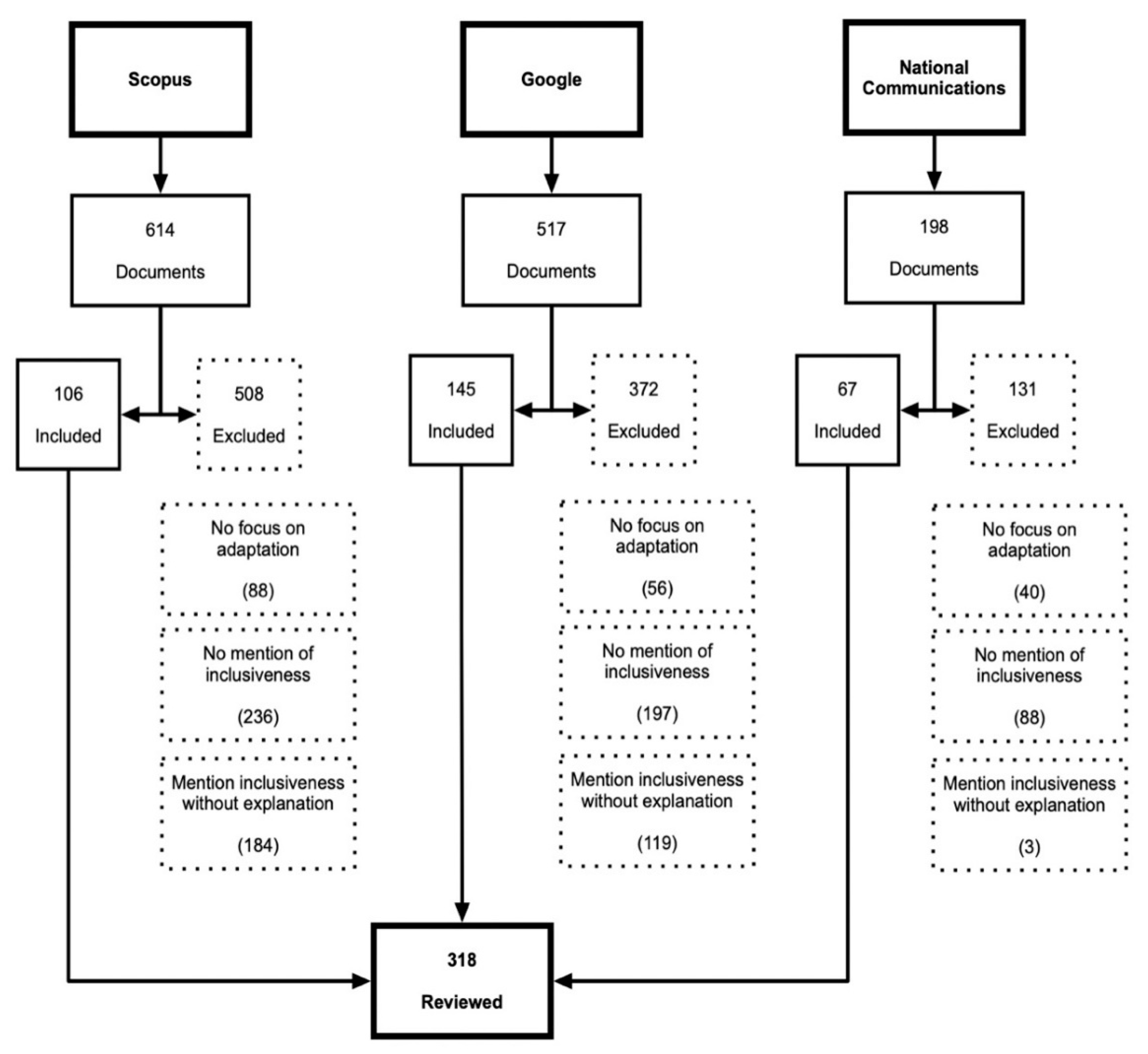
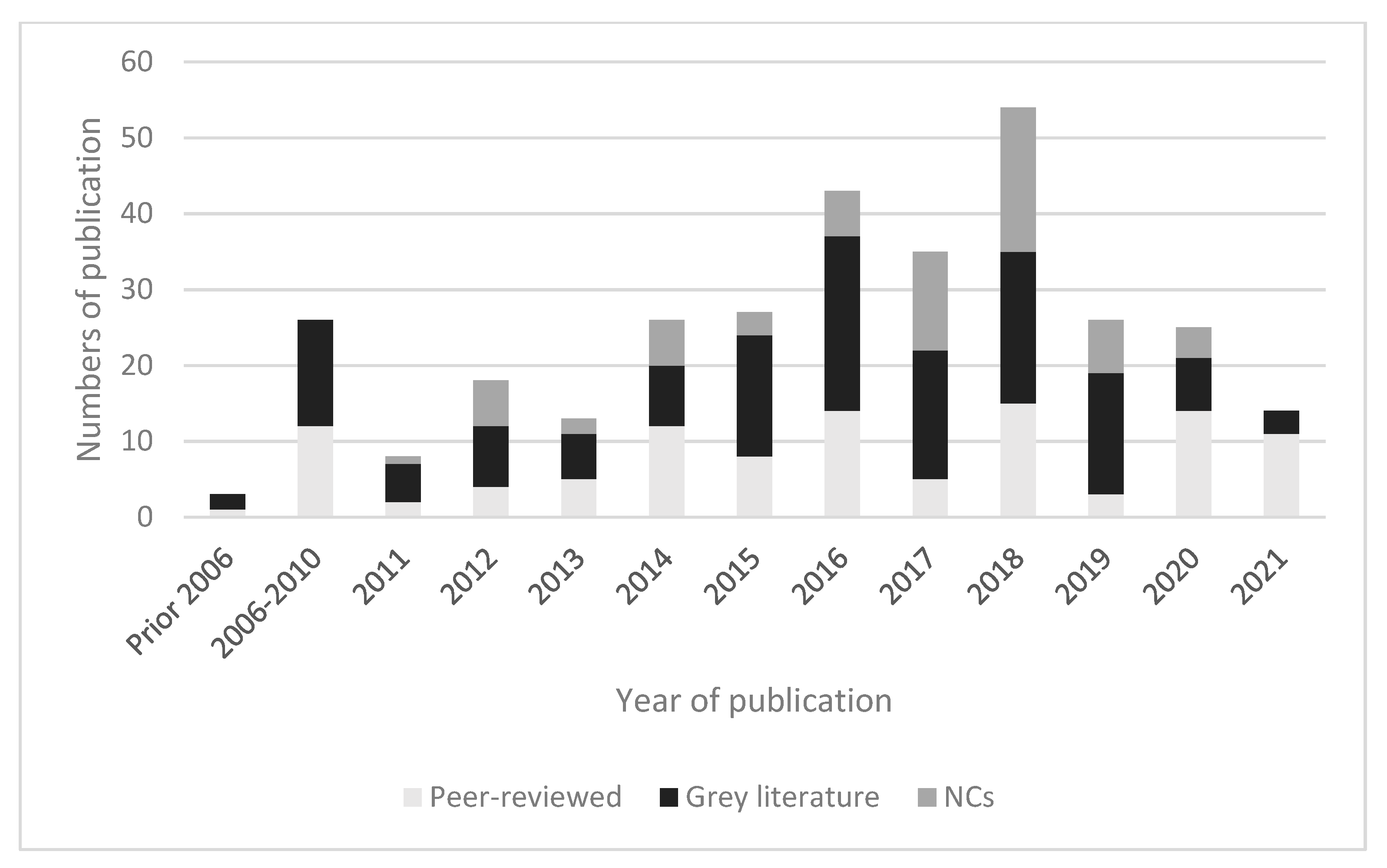
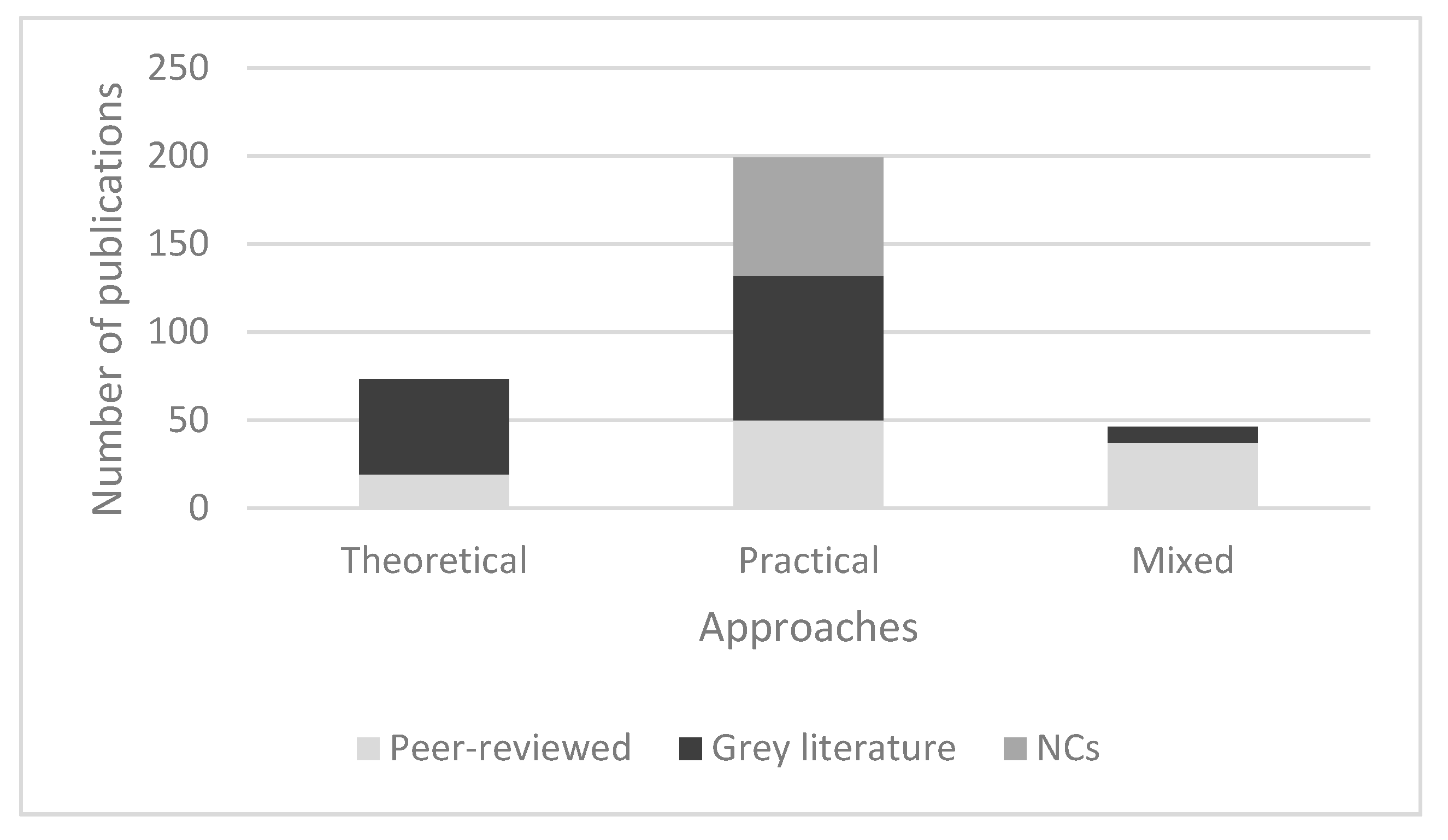
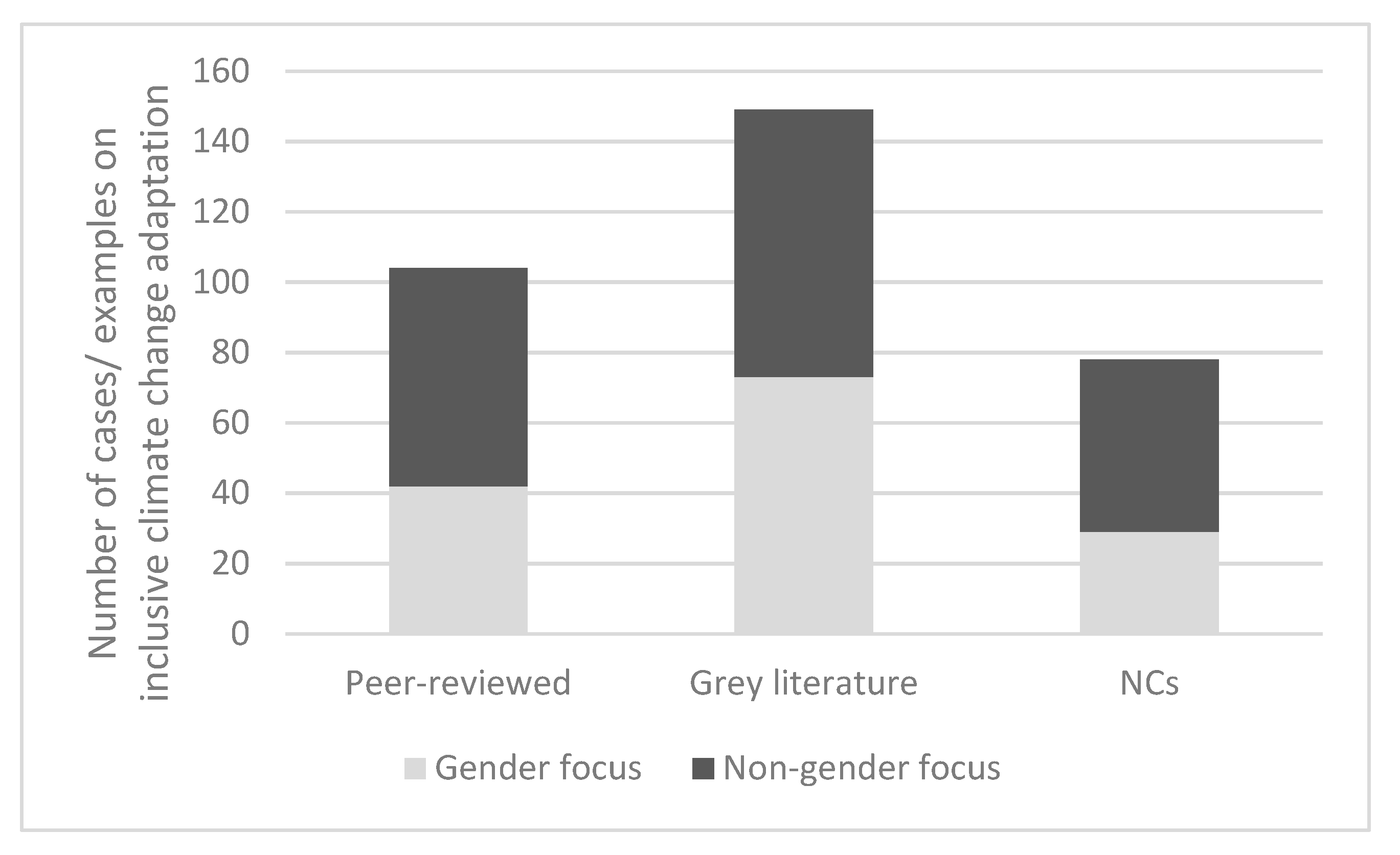
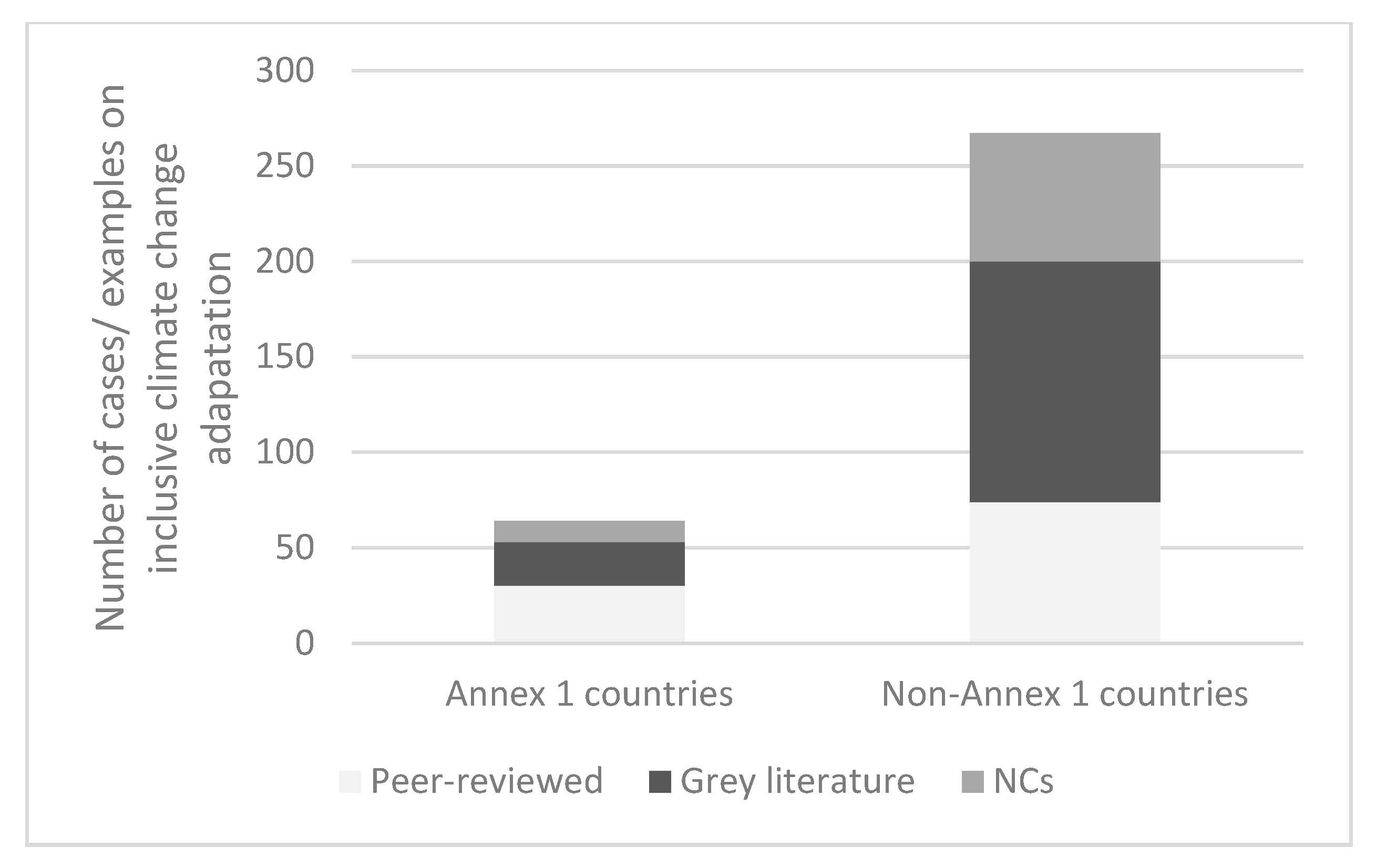
| Inclusion Criteria | Exclusion Criteria |
|---|---|
| Text in English | Text in other languages |
| Full text available | Only abstract or partial text available |
| Human response to climate change | Biological response to climate change |
| Adaptive response to climate change | Vulnerability, mitigation only |
| Refers directly to inclusiveness | Does not refer to inclusiveness |
| Sufficient detail for data extraction | Insufficient detail for data extraction |
| General Questions | ||
| Lead author? | ||
| Year published? | ||
| Region of interest: | Annex 1? Non-Annex 1? | |
| Approach: | Conceptual? Practical (Example or Case)? | |
| Specific questions | ||
| Who or what to include | ||
| Scale: | Local and community? National? Regional? International scales? Necessity to cooperate across scales? | |
| Stakeholders: | A broader spectrum of actors? | Local people and local communities? Governments, including local and national levels? The private sector? Experts and research communities? NGOs and civil society? International actors, networks, and agencies? |
| Vulnerable groups? | The poor? People with disabilities? The indigenous? Women and girls? Resource-dependent people? | |
| More than human–others? | ||
| Knowledge: | Traditional? Expert? | |
| Techniques or tools: | Participatory (action) research approaches? Qualitative scenarios? A programming model? Adaptation design tool? Social ecological inventory (SEI)? | |
| How to include (adaptation activities and capacity required to adapt) | ||
| Governance? Institution? Social capacity? | ||
| Outcomes | ||
| Consideration of the vulnerable groups? Adequate participation? Just results? A status of resilience, inclusive development, and sustainability? | ||
Publisher’s Note: MDPI stays neutral with regard to jurisdictional claims in published maps and institutional affiliations. |
© 2021 by the authors. Licensee MDPI, Basel, Switzerland. This article is an open access article distributed under the terms and conditions of the Creative Commons Attribution (CC BY) license (https://creativecommons.org/licenses/by/4.0/).
Share and Cite
Pham, H.; Saner, M. A Systematic Literature Review of Inclusive Climate Change Adaption. Sustainability 2021, 13, 10617. https://doi.org/10.3390/su131910617
Pham H, Saner M. A Systematic Literature Review of Inclusive Climate Change Adaption. Sustainability. 2021; 13(19):10617. https://doi.org/10.3390/su131910617
Chicago/Turabian StylePham, Ha, and Marc Saner. 2021. "A Systematic Literature Review of Inclusive Climate Change Adaption" Sustainability 13, no. 19: 10617. https://doi.org/10.3390/su131910617
APA StylePham, H., & Saner, M. (2021). A Systematic Literature Review of Inclusive Climate Change Adaption. Sustainability, 13(19), 10617. https://doi.org/10.3390/su131910617






